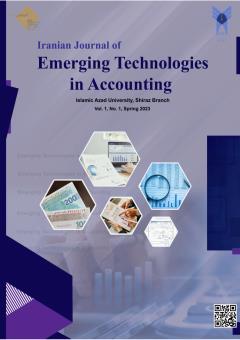Studying the Impact of the Value Added Tax on Profitability and Survival of the Companies in Tourism Industry (Case study: Hotels in Tehran)
محورهای موضوعی : تکنوژی های نوظهور در حسابداریMohammad Hosein Fatheh 1 , Ahmad Hasanpor 2
1 - Assistant Professor, Department of Accounting, Payame Noor University,Tehran, Iran.
2 - MSc. Department of Accounting, Payame Noor University,Tehran, Iran.
کلید واژه: Value Added Tax, Profitability and Survival of the Company, Tourism Industry,
چکیده مقاله :
Objective: The present study aimed to trace Studying the Impact of the Value Added Tax on Profitability and Survival of the Companies in Tourism Industry (Case study: Hotels in Tehran) Methodology: According to the value added tax law and activities of tourism industry that are subject to value added tax exemptions, this study examines the impact of value added tax on the profitability and survival of the companies in the tourism industry in Tehran hotels. The research method is quasi-experimental and retrospective conducted by using retrospective data in the accounting research scope based on real data. The analysis of the data was done in two sections; before and after the valued added tax increase: descriptive statistics included 30 sample hotels during a period of 12 years (2007 to 2019) and the number of year- hotel (360). Results: The results showed that increase of value added tax has a significant inverse effect on the profitability of the hotels in the country implementing this law. Innovation: Considering the importance of the tourism sector in promoting the economic growth of developing and developed countries, several empirical studies have been conducted on factors affecting tourism demand in recent years. In this regard, the relationship between the tax rates as one of the government's financial instruments and the profitability of the tourism industry has been less considered in tourism studies.
Objective: The present study aimed to trace Studying the Impact of the Value Added Tax on Profitability and Survival of the Companies in Tourism Industry (Case study: Hotels in Tehran)
Azizi, Zahra; Mansouri Kasvai, Mansoureh (2021). Studying the impact of value added tax on trade and comparing with oil-exporting and non-exporting countries, Program and Development Research Quarterly, 2(6), p. 79 - 104.
Barati, Javad and Rasulzadeh, Maryam (2022). Analysis of price effects of VAT reform in the tourism industry: Input and Output Analysis, Scientific and Research Quarterly of Tourism Planning and Development, Vol.11, No. 42, pp. 89-112.
Chiharghani, Ahmad and Zaranjad, Mansour (2019). Investigating the effect of value added tax on Iran's economic growth using Computable General Equilibrium Model (CGE), Scientific Quarterly, Economic Growth and Development Research, 9(36), pp. 109-128.
Ernst & Young. (2012). The Worldwide VAT, GST and sales tax Guide, Ernst & Young’s Tax Services.
Feshari, Majid; Taghipour, Ali Akbar; Vali Beigi, Mojtabi and Qamari, Nair (2011). The effect of tax rate on tourism foreign exchange income in Middle Eastern and North African countries (Dynamic panel data approach), Economic Modeling Quarterly, Vol. 5, No. 16(16), pp. 71-86.
Hair Jr, Joseph F., G. Tomas M. Hult, Christian M. Ringle, & Marko Sarstedt (2017). A primer on partial Least squares structural Equation Modeling (PLSSEM). SAGE publications kindle Edition.
Hoseini, Mohammad, & Oceane Briand (2020). Production efficiency and self-enforcement in value-added tax: Evidence from state reform in India, Elsevier journal of Development Economics.
Kia, Behzad; Jafari Samimi, Ahmed; Farhadi Mohali, Ali; Tabari, Mojtabi (2021). Investigating the identification of criteria and standards evaluations of value added tax policy, Scientific Quarterly Journal of Islamic Economics and Banking, no37, winter 2021, pp. 185-202.
Kisanga, Elineema, Vincent Leyaro, Wahabi Matengo, Michael Noble, Helen Barnes, & Gemma Clare Wright (2021). Assessing the distributional impact of lowering the value-added tax rate for standard-rated items in Tanzania and option for recouping revenue losses. February 2021‘UONGOZI Institute.
Kolahi, S. H. G., & Noor, Z. B. M. (2016). The effect of value add tax on economic growth and its sources in developing countries. International Journal of Economics and Finance, 8(1), 217-228.
Kristjánsdóttir, H. (2021). Tax on tourism in Europe: Does higher value added tax (VAT) impact tourism demand in Europe? Current Issues in Tourism, 24(6), 738-741.
Lambi, C. (2017). Assessing the Impacts of a Major Tax Reform: a CGE-microsimulation analysis for Uruguay. International Journal of Microsimulation. 9(1): 134-166
Mariscal, Rodrigo, & Alejandro M. Werner. (2018). The price and welfare Effects of the value-added tax: Evidence from Mexico, IMF working paper WP//8/240.
Mateus, C., & Mateus, I. B. (2021). Does a VAT rise harm the tourism industry? Portuguese evidence. Tourism Management, 83, 104234
Timmermans, Benoît, & Wouter MJ Achten. (2018). From value-added tax to a damage and value-added tax partially based on life cycle assessment: principles and feasibility. The International Journal of Life Cycle Assessment, 23(11), 2217-2247. http : //doi .org /10, 1007/ s 11367-018-1429-7.
Zou, Jingxian, Guangjun Shen, & Yaxian Gong. (2019). The effect of value added tax on leverage: Evidence from China’s value-added tax reform. China Economic Review, 54, 135-146.


